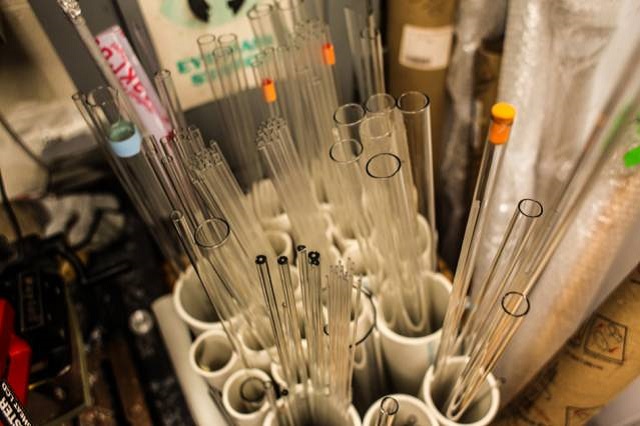 Different kinds of low-cost silicon dioxide tubes and rods sit in the lab. Researchers experimented by filling these tubes with a variety of metals to make a preform. When they tried aluminum, they found unexpected results.
Different kinds of low-cost silicon dioxide tubes and rods sit in the lab. Researchers experimented by filling these tubes with a variety of metals to make a preform. When they tried aluminum, they found unexpected results.
Researchers at MIT have developed a new method that could transform the development of high-quality fiber-based electronic devices.
The latest concept evolved from a long-term study to design multifunctional fibers that integrate different types of materials into one long functional strand. So far, these long strands can only be produced by organizing the materials in a large cylinder or block known as a preform. This preform is heated and expanded to produce a thin fiber, which has a smaller diameter and yet has the same composition.
For the first time ever, fibers produced through this technique can have a composition that is entirely different than the starting materials. This marks a major advancement that converts abundant and low cost materials into high-value ones. The study has been published in the journal Nature Communications and was co-authored by Chong Hou, a graduate student, and six others from MIT and Singapore.
The fibers are produced from silica glass and aluminum metal, which are low-cost materials and often utilized to develop windows and window frames. As these materials are heated and drawn, they react chemically and produce a fiber having a center of pure, crystalline silicon and a silica coating. The pure, crystalline silicon is used as a raw material in the fabrication of solar cells and computer chips.
In the experiments used to analyze the possibilities of integrating metal wires into fibers, Hou tested a wide range of metals such as aluminum, copper, and silver and in the former case, the outcome was not what the researchers had anticipated. Their first reaction was to discard the sample when they observed that the experiment did not create the desired effect. However, upon examination, they found that the core had changed into pure, crystalline silicon. This is how this breakthrough came about.
Later, it was observed that the chemical reaction in the fiber was an established one. When a high temperature is utilized for drawing the fiber (2,200°C), the pure aluminum core reacts with a form of silicon oxide, silica. The reaction results in pure silicon and aluminum oxide. The former material concentrates in the center of the fiber, while the latter deposits a thin layer of aluminum between the center and the silica cladding.
When I looked at the fiber, instead of a shiny metallic core, I observed a dark substance; I really didn’t know what happened. We can use this to get electrical devices, like solar cells or transistors, or any silicon-based semiconductor devices, that could be built inside the fiber.
Chong Hou
Hou further said that many teams have attempted to produce such devices within fibers, but until now all those methods called for costly, high-purity silicon. Now, using a low-cost metal, silicon-core fibers could be produced.
According to Fink, head of MIT’s Research Laboratory of Electronics and professor of materials science and electrical engineering, this provides a new approach wherein a fiber is drawn, which is drastically different from its perform. This paves the way for new possibilities in fiber devices and fiber materials through value-added processing.
The researchers are also working to create particular structures, such as an electrical junction within the material as it is drawn.
As more and more mobile devices continue to emerge in the electronics business, this technology could give way to innovative possibilities for electronics, such as microchips and solar cells, to be woven into clothing and accessories or integrated into fibers.
Optical fibers are central to modern communications and information technologies, yet the materials and processes employed in their realization have changed little in 40 years. Of particular importance here is that the starting and ending core composition are entirely different. Previous work focused on chemical reactions and interactions between core and clad phases, but never such a wholesale materials transformation, said John Ballato, director of the Center for Optical Materials Science and Engineering Technologies at Clemson University in South Carolina, who did not participate in the study.
This work is simply beautiful. This new strategy will enable the fabrication of new classes of functional fibers that would otherwise be difficult, if not impossible, using the traditional approach, said Henry Du, a professor of chemical engineering and materials science at Stevens Institute of Technology in Hoboken, New Jersey, who also was not involved in this study.
In addition to Hou, the research team included John Joannopoulos, Xiaoting Jia, and Xin Zhao at MIT; Swee-Ching Tan at the National University of Singapore; and Lei Wei at the Nanyang Technical University in Singapore.
The research was supported by the National Science Foundation and by the U.S. Army Research Office and the U.S. Army Research Laboratory through the Institute for Soldier Nanotechnologies at MIT.
References